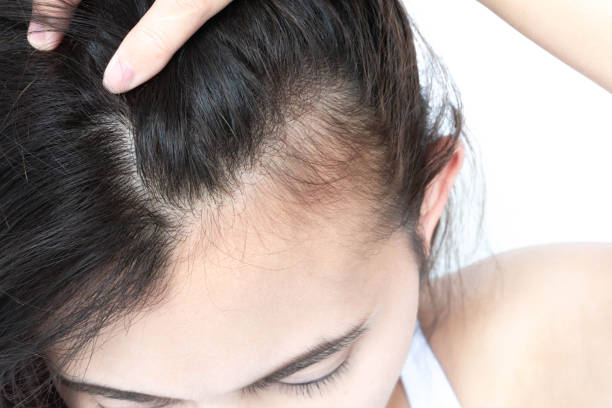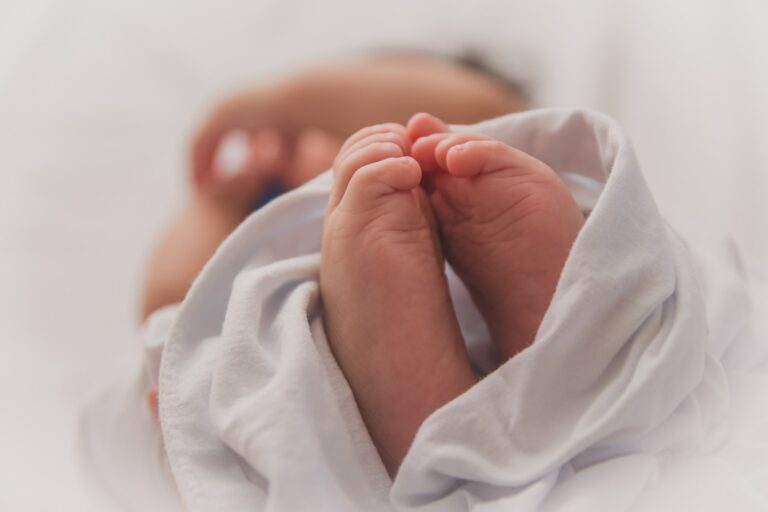Postpartum Hair Loss And How Best To Treat It

Most new moms experience postpartum hair loss. Since it’s such a common and important issue, we’re going to discuss the following to help you learn more about it:
- Hair Loss After Giving Birth
- General Postpartum Health
- Is Postpartum Hair Loss Normal?
- Hair Growth Cycles
- Why Does Postpartum Hair Loss Happen?
- How Is This Possible If My Hair Is Thicker And Fuller During Pregnancy?
- What Can Mothers Do To Help With Postpartum Hair Loss?
- When Does Hair Loss Become A More Serious Issue?
HAIR LOSS AFTER GIVING BIRTH
After giving birth, women tend to experience a number of changes, which range from exciting to unsettling. This is a miraculous time in the human life cycle and naturally involves readjusting to life and healthy routines. One stark change that many women notice after giving birth is an increase in hair loss. In the shower, after sleeping, or after brushing one’s hair, the amount of hair shed each day tends to escalate dramatically. This change can cause a sense of fear and frustration in women who experience postpartum hair loss, but don’t worry– it is not a cause for concern.
GENERAL POSTPARTUM HEALTH
An increase in hair loss is completely typical for postpartum women, but it is a precarious time for the human body. This is a time when the body is susceptible to infection and fatigue, and it is just important to take care of yourself after giving birth as it is during pregnancy. Some doctors recommend eating an entirely organic diet after giving birth in order to minimize the intake of toxins.
For mothers who breastfeed, this is of additional importance, as to ensure that your baby is not ingesting pesticides. Furthermore, organic skincare should also be used during the postpartum period. Plant Mother’s Vitamin C Serum and Retinol are entirely organic and plant-based, and provide the perfect skincare regimen for even the most sensitive of skin. Better yet, Plant Mother’s products are completely free of any chemicals or artificial ingredients that new mothers would want to keep away from their babies.
Some pregnant women are told to avoid retinol products, but Plant Mother’s Retinol containing organic bakuchiol is completely safe for women experiencing hormonal changes. Pregnancy and the postpartum period can feel terrifying, as there are so many choices to be made while your body is going through seemingly endless transitions. When in doubt, stick to healthy organic products that you can trace back to the source in order to protect yourself and your baby. It is also important to know how to balance hormones, before and after your pregnancy.
IS POSTPARTUM HAIR LOSS NORMAL?
Postpartum hair loss is entirely normal. After giving birth, many women notice that their hair is shedding at a higher frequency than normal. In the postpartum period, you may notice stray hairs remaining on your pillowcases or on the bathroom sink. This is because your body experiences a number of changes after giving birth, including hormonal shifts that impact areas you may not expect.
During typical periods of hair growth, humans shed 100 hairs per day. This may seem like more than we would expect, but hairs are shed when we brush, style, wash, and rearrange our hair. During the postpartum period, some women note losing 300 hairs per day, a dramatic increase that is easily noticeable. There are scientific explanations for why this occurs, but that doesn’t make it any less jarring. If you are a woman who has given birth in the past few months and are experiencing an increase in hair loss, the first thing you need to know is that this shedding is completely normal and is not a sign that something is seriously wrong. Secondly, there are steps you can take to protect your hair growth and encourage your luscious locks to return to normal.

HAIR GROWTH CYCLES
In order to understand why postpartum hair loss occurs, we first must understand how normal hair growth happens. Human hair growth occurs in cycles, involving three different stages. These phases are called anagen, catagen, and telogen. Anagen involves the creation of a new hair follicle and last several years while the hair continues to grow. The catagen period is shorter, followed by the telogen stage, during which hairs prepare to shed. Essentially, the three subsequent phases involve growing, resting, and regressing.
Different hair types and sources of hair across the body involve varying lengths of growth and shedding, but this is the general pattern. There are tons of suggestions for how to encourage robust hair growth, including scalp massages, supplements, and following a healthy diet. Further, we know that there are behaviors that harm hair growth and damage existing hair. For example, using excessive heat for style can damage follicles and create a brittle appearance.
Constantly dying or bleaching one’s hair is also quite detrimental to hair health, and so is any consistent use of chemicals. There are some patterns of hair loss that are unavoidable, but there are still many preventative measures that can be taken to encourage hair growth and preserve health.
WHY DOES POSTPARTUM HAIR LOSS HAPPEN?
Alopecia refers to hair loss that occurs when the body’s immune system works to damage hair follicles. Alopecia can be caused by a number of factors, a prominent one being intense stress. Specifically, postpartum alopecia occurs in many women after they give birth, as changing hormone levels impact the hair growth cycle. The scientific name for this form of hair loss is telogen effluvium, and it typically begins a few months after giving birth.
During pregnancy, hormone levels are elevated, including the amount of estrogen in the female body. When estrogen levels drop after giving birth, our bodies move quickly from the anagen to the telogen stages. This means that our hair follicles switch from growing to shedding. Further, a shortening of the anagen phase and a lengthening of the telogen phase may correspond with miniaturization, or the shrinking of hair follicles. Hair follicles impacted by miniaturization tend to grow hairs that are thinner and shorter, worsening the impact of telogen effluvium. All of these factors combine to increase hair fallout, slow the return of hair, and weaken strands. Although postpartum hair loss is natural, it can still be quite disheartening for women who experience it.

HOW IS THIS POSSIBLE IF MY HAIR IS THICKER AND FULLER DURING PREGNANCY?
Postpartum hair loss comes as a shock to some, especially because many women experience full, luscious, and healthy hair during pregnancy. Throughout the gestational period, estrogen levels are higher, extending the anagen period and allowing hair to grow longer and thicker before the inevitable telogen phase. Therefore, postpartum alopecia is quite the unwelcome surprise to women who are experiencing all sorts of other symptoms and hormone changes and who have spent the past nine months with their hair feeling quite healthy. However, these changes demonstrate just how normal it is for our bodies to be impacted by the process of giving birth and how almost every biological process moves in cycles.
Even when a woman takes excellent care of her health and hair, changes in hormone levels interact with the growth cycle and impact the follicle strength. Hopefully, understand that these changes are completely natural can help put the mind at ease. In fact, increased estrogen levels after giving birth are a sign that the body is behaving precisely as it should.
WHAT CAN MOTHERS DO TO HELP WITH POSTPARTUM HAIR LOSS?
Because postpartum hair loss is a natural process, there is no way to completely avoid it. Nevertheless, there are steps that you can take to protect the hair’s health and improve its appearance. Many experts recommend scalp massages as a method of stimulating hair growth. According to a 2016 study, performing a scalp massage for a few minutes each day does translate to increased hair growth. There are many scalp massaging brushes available on the market, a popular new tool that can be used daily in the shower. These brushes can be used in combination with volumizing shampoos and conditioners, and products with vegan, chemical-free keratin.
However, you certainly don’t need to purchase any fancy hair care products in order to stimulate growth. You can give yourself a scalp massage with just your fingers by massaging your shampoo and conditioner into your head for a few minutes in the shower. Also, there’s a growing trend of women using hyaluronic acid for hair. They noticed that their hair gets softer and better moisturized as well as less prone to breakage after hyaluronic acid treatment.
Some people recommend essential oils for hair growth, but you’ll want to do a patch test first in order to avoid potential allergic reactions. If all of this feels like too much effort on top of the other stressors of new motherhood, then don’t worry about it! Your hair will return to its normal growth cycles, and if it becomes too much of an annoyance, why not try a big chop? A shorter hairstyle tends to allow for easier volume and certainly cuts down on styling time. Maybe it’s time to switch it up for this new chapter in your life!
WHEN DOES HAIR LOSS BECOME A MORE SERIOUS ISSUE?
Although postpartum hair loss is entirely normal and predictable, it’s important to keep an eye on any major changes that you notice. Your hair should have return to its normal growth cycles by the time your child is a year old. If you are noticing continued major hair loss around this time or missing patches throughout your scalp, it might be time to consult your doctor.
Extensive hair loss could be a sign of nutritional deficiencies, in which case you should definitely ensure that you are eating a balanced diet and getting all of the essential nutrients you need for a healthy life. There are many other issues that could potentially be causing alopecia in postpartum women, such medical conditions like thyroid problems, iron deficiency, diabetes, or lupus. For these reasons, it’s important to keep up to date with your medical checkups during the postpartum period. It can be hard to keep track of all of the changes in your lifestyle and your body, so don’t be afraid to ask your doctor any questions about concerns you may have.
Eating a balanced diet and sticking to clean, organic skincare such as Plant Mother’s Vitamin C and Retinol serums are two ways that you can set yourself up for a healthy lifestyle after giving birth. Pregnancy and the postpartum period are times of miraculous changes in the human body, so don’t forget to give yourself time and space to reflect and readjust. And remember– hair grows back!
MEDICAL DISCLAIMER
This content is for informational and educational purposes only. It is not intended to provide medical advice or to take the place of such advice or treatment from a personal physician. All readers of this content are advised to consult their doctors or qualified health professionals regarding specific health questions. The publisher of this content does not take responsibility for possible health consequences of any person or persons reading or following the information in this educational content. All viewers of this content, especially those taking prescription or over-the-counter medications, should consult their physicians before beginning any nutrition, supplement, skincare product, or lifestyle program.
